Micil and the return of Galway whiskey
It’s a season of west coasting. One week on the pink granite coast, and now taking a drive from the Flann O’Brien-haunted pubs of Dublin to the bogs of Connemara. I’m standing (somewhat precariously) atop a pile of boulders, themselves hidden within a copse of dwarf oaks.
‘It’s down here,’ comes a voice from far below. ‘You can see the floor of the kiln and the chimney.’ I take his word for it. The voice belongs to Pádraic Ó’Griallais, co-owner with brother Jimín and Ross Tobin of Galway’s Micil distillery. We’re out here to cut turf and listen to his family’s story of poitín making.
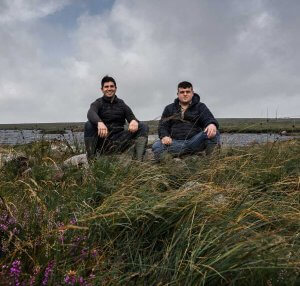
The boulders once formed a cave where the barley, steeped in the nearby lough could be germinated and kilned over a fire, fuelled by the peat cut from the surrounding bog. ‘The Excise found it,’ Pádraic explains as he clambers up, ‘so they set explosives and blew it up.’ The family simply moved operations elsewhere.
It wouldn’t have been the first time there had been a run-in with the authorities. The brothers are sixth generation poitín makers something following in the path of their great-great-great-grandfather, Micil MacChearra who began the family tradition in 1848.
They still make it, albeit legitimately (poitin was legalised in 1997), but adhere to the old family recipe which their great-grandfather taught them: barley-based, with bogbean added. It’s gentle, soft, and sweet. The Heritage version speaks more of the older style, adding in some oats for creaminess and a touch of smoke.
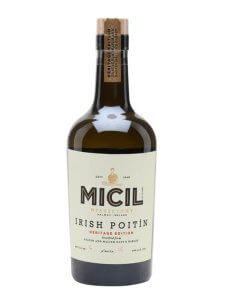
For Pádraic and Jimín there’s more to their distilling than just making a brand. It is about revealing a hidden and misunderstood element of Irish whiskey’s history.
Poitín, we were told, was rotgut made from potatoes, a crude, blue-tinged methanol-riddled spirit that made you blind, drove you mad. You might be charmed by the seductive allure of the illicit, but drink it at your peril. Yet those who knew their booze knew the truth, that the best makers were skilled distillers.
Poitín was on the wrong side of the battle between town and country, business and farmer, Government and ‘rebels’. The first fracture in Irish whiskey didn’t come in the 1820s with the arrival of the column still – as the authorised history would have it – but in 1660 with the split between ‘Parliament’ (legal) whiskey made according to the law in cities and market towns and (illegal) poitín produced in the countryside.
The former would evolve into the glories of single pot still which became the defining Irish style, while poitín – mostly made from malted barley usually smoked, then double-distilled in small pots – began to acquire its bad reputation. Looked at from this angle, that illicit hooch was Ireland’s single malt. (And yes I know that under the new definition sugar beet molasses and potatoes can be used as well as cereals as a base). The continued making of poitín, and its being brought into the light of legality, is a story of retention of culture and place.
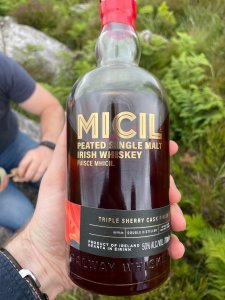
Pádraic produces a bottle. There’s a dark-fruited element, accompanied by a zingy acidity balancing the thick texture and sweet, subtle smoke, ‘that’s very Connemara. There’s none of that seaweedy Islay stuff here.’ There is balance, layering. Until now, Micil’s whiskeys have used sourced stock. This, as he proudly points out is the first 100% Galway whisky for well over 100 years. Aged in a mix of 50l sherry casks – PX, amontillado, and palo cortado it links the traditional size of cask used by poitín makers with the fact that Galway city was home to the Spanish trade. Like so many new distilleries, there’s an acute sense of the past in their making.
[This first release, all 360 bottles of it sold out almost immediately… but more is on the way]
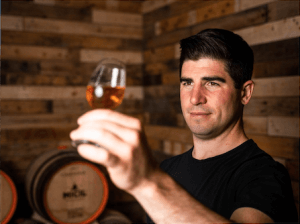
Up to 22 legal (Parliament) distilleries were operational in the county during the 18th and 19th centuries. The last standing was Persse’s Nun’s Island in Galway city which at its height was making 400,000 gallons of single pot still a year, bottled at seven and 10 years old, a break from custom at a time when most of Ireland’s big distilleries were selling direct to bonders.
The strategy didn’t work. In 1908, Nun’s Island closed, though the building that housed its its massive maltings/mill remains. It’s a stark reminder of not just the great fall of Irish whiskey, but also the contrast between the grandiose Parliamentary approach and the modest old ways.
The Micil distillery is two miles away from Nun’s Island, at the back of a brewpub in Salthill on the shore of Galway Bay. Inside, the first language is Irish. It’s how Pádraic and Jimín talk and think. It links them to land and culture, a navigation of place and identity.
Having a 170 year perspective helps. For Pádraic, Micíl is not just a distillery, but a way to redress the balance and reveal the true story of distilling in Galway and Connemara.
We could keep exploring the coast – back to Noel Ó’Lochlainn’s Burren distillery, further south to Dingle, or north to Donegal where that county’s lost history – it was once the heartland of illicit production – is being revived by James Doherty at his Sliabh Liag/Ardara distillery.
Then we could head across the North Channel to Islay or Campbeltown. Like the winding and rewinding of Celtic knot work, tides and currents carry information and ideas along the Atlantic coast.
I follow that route and a week later I’m on Islay, catching up with old friends. They hand out gifts – old single malts for two of us and a small bottle of clear liquid for me.
‘Some folks took a RIB over from Donegal,’ comes the explanation. ‘They left with Lagavulin and left us a lemonade bottle of this.’ It smells of rhubarb and custard, sweetly spiced, soft. Poitín. The old style. The links of the chain still hold.
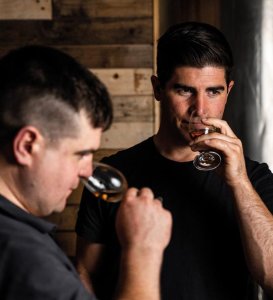
There is a link between the distilleries on the Scotland’s western shores, one which isn’t necessarily stylistic – they don’t all taste the same – but a shared sensibility, seen most clearly in the recent moves to create distilleries which are hubs for their community, somewhere that a career can be made.
It doesn’t just apply solely to whisky, it could equally be music, writing, food, weaving, etc… some of many manifestations of place-centred revival.
Maybe these thoughts only come because I feel most at home here in the ragged west, that land of bog and grass, sandblown machair and its flowers. As you head to the coast, so the skies widen, and as they do so the mind begin to moves differently. It’s to do with looking out, not back.
In that light, this is a place of possibilities, yet the Atlantic west is also a place of famine and clearance, home to remnants of cultures as wind-and-wave-tattered as the coastline. Holding out and holding on. Preserving. Now, perhaps, these marginal lands are gaining a new relevance, building a future.
PS
I’d finished this piece and begun a book of Kevin Barry’s short stories. In ‘Saint Catherine Of The Fields’ this appeared. It made me happy.
‘On a free weekend in October, I drive out west from the city. The usual loosening occurred as I crossed the Shannon river. It’s hard to describe it except as a feeling of openness that descends on me, a kind of receptivity. It’s something I never experience in Dublin, as if certain signals are blocked to me there.’